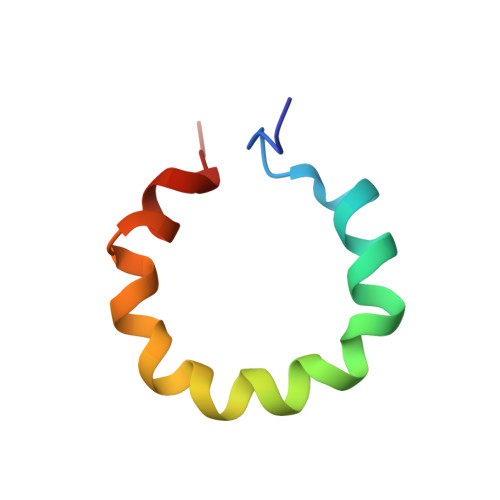Folded Alpha Helical Putative New Proteins from Apilactobacillus kunkeei.
Ye, W., Krishna Behra, P.R., Dyrhage, K., Seeger, C., Joiner, J.D., Karlsson, E., Andersson, E., Chi, C.N., Andersson, S.G.E., Jemth, P.(2024) J Mol Biol 436: 168490-168490
- PubMed: 38355092
- DOI: https://doi.org/10.1016/j.jmb.2024.168490
- Primary Citation of Related Structures:
8QNJ, 8QNT, 8QNV - PubMed Abstract:
The emergence of new proteins is a central question in biology. Most tertiary protein folds known to date appear to have an ancient origin, but it is clear from bioinformatic analyses that new proteins continuously emerge in all organismal groups. However, there is a paucity of experimental data on new proteins regarding their structure and biophysical properties. We performed a detailed phylogenetic analysis and identified 48 putative open reading frames in the honeybee-associated bacterium Apilactobacillus kunkeei for which no or few homologs could be identified in closely-related species, suggesting that they could be relatively new on an evolutionary time scale and represent recently evolved proteins. Using circular dichroism-, fluorescence- and nuclear magnetic resonance (NMR) spectroscopy we investigated six of these proteins and show that they are not intrinsically disordered, but populate alpha-helical dominated folded states with relatively low thermodynamic stability (0-3 kcal/mol). The NMR and biophysical data demonstrate that small new proteins readily adopt simple folded conformations suggesting that more complex tertiary structures can be continuously re-invented during evolution by fusion of such simple secondary structure elements. These findings have implications for the general view on protein evolution, where de novo emergence of folded proteins may be a common event.
Organizational Affiliation:
Department of Medical Biochemistry and Microbiology, Uppsala University, BMC Box 582, 75123 Uppsala, Sweden.














